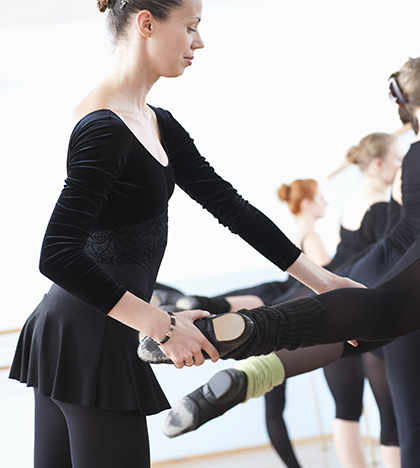Dance Teachers: Here’s How to Get Your Students to Apply Their Corrections
 By Steve Sirico of Dance Teacher Web
By Steve Sirico of Dance Teacher Web
Giving corrections and having your students apply them can be challenging at times. Especially in today’s world where getting a correction can be viewed as a real negative. You know the ones who seem to shrink when you give them a tip, correction or advice and the next thing you know, the tears well up in their eyes. Or the ones who say to you “I didn’t do that!” Yes- that one drives me crazy! So right at the start of the year we always set the ground rules with the students about how a correction really is a gift. We even review this at the start of every year so that the returning students, no matter what level will continue to receive corrections.
Tough love time!
From time to time, you will most likely need to be a little harder on your students. The key here is that before you can do so you will need to establish trust and understanding with the students. Even then, you will need to proceed with caution and know that some students will not respond positively to a harsher approach. However, I do believe that you do sometimes need to “drop the hammer!”
Tips to help build trust:
- As the saying goes, “people don’t care about how much you know until they know how much you care!” Setting the right atmosphere in the classroom is critical to building the right environment. Calling the students by name is very important. Boosting first is always a good idea. Now I don’t believe is saying something nice for no reason at all but finding the good in each student and mentioning it will go a long way. Remember, if they feel like you care about them, they will do just about anything for you.
- Setting ground rules early on is a big factor in having a successful season. Talking about how to use the corrections you will be giving them is a good baseline to have and refer to as the year moves forward.
- Keep in mind that some students are going to have trouble feeling the correction and applying it. Some may need a hands on approach. Some may need to see another student who is doing it correctly so they can understand what you are saying. Not every student is an auditory learner.
- When you do come down a bit hard always try to have a little group talk near the end of class to explain why you are pushing harder.
- Never belittle or degrade any student. I like to use the words “Focus” or “Listen and Apply!” then you can explain that this correction that has been given repeatedly will not be fixed by magic. It takes two to get better. The teachers, giving tips and corrections and the students, listening and working to make the corrections. This applies to working on technique and choreography.
- Sometimes being a little forceful and loud can make an impact. When you do always end the class or rehearsal with a smile on your face. It will let them know there are no hard feelings.
- Never ever accept bad behavior! If a student is disrespectful I recommend that you dismiss them from class. Check with your studio director to make sure this is part of their policy. But I think that telling a student that you do not accept bad behavior and that they are done dancing for the day sends a clear loud message to the rest of the class that you have zero tolerance for bad behavior. Once you dismiss them from the class, direct them to go to the front desk where they can sit and wait for a meeting after class to discuss how to rectify the situation. Again, I recommend that you have your studio director in on any meeting you may have.
Even with all of this in place, there will be times when tears will flow and you may be accused of devastating your student. Don’t sweat it! Just talk to the studio director and explain what took place. Then they can set up a meeting with parents and students if needed. If not, then you can plan your strategy for the next class on ways that you can repair their trust. It will be work sometimes and they will need to be encouraged to keep the faith in regards to accepting corrections.
Try this: After every class, have your students come up and say thank you to you. In return you can look them in the eye and say thank you back for their hard work and effort. We have been doing this since we started our studio 29 years ago and it really does have the students leave the class with a thankful heart and mind no matter what took place during the class. To start implementing this into your classes, just inform your students that you are starting a new and exciting way to exit the room after the class. These sort of habits are going to help them in life and teaching them to say “Thank You” will make them stand out in a crowd. As they leave the room they come up to you one at a time say thank you, the girls can curtsy and the boys can bow. Look each student right in the eye and say thank you back with a bow of your head. On a side note, the parents when they see this will love it to! Manners are unfortunately fading away and if we can give our students this one life skill they will be happier and better people.
Now how good does that sound!


